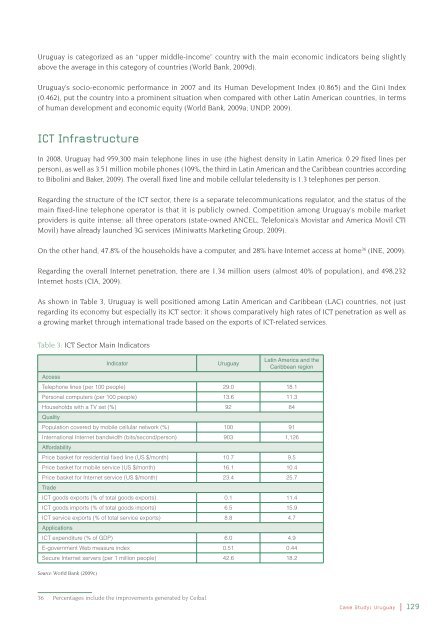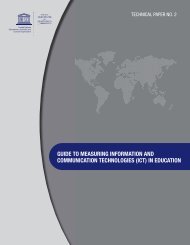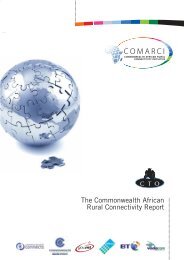Transforming education: the power of ICT policies - Commonwealth ...
Transforming education: the power of ICT policies - Commonwealth ...
Transforming education: the power of ICT policies - Commonwealth ...
You also want an ePaper? Increase the reach of your titles
YUMPU automatically turns print PDFs into web optimized ePapers that Google loves.
Uruguay is categorized as an “upper middle-income” country with <strong>the</strong> main economic indicators being slightly<br />
above <strong>the</strong> average in this category <strong>of</strong> countries (World Bank, 2009d).<br />
Uruguay’s socio-economic performance in 2007 and its Human Development Index (0.865) and <strong>the</strong> Gini Index<br />
(0.462), put <strong>the</strong> country into a prominent situation when compared with o<strong>the</strong>r Latin American countries, in terms<br />
<strong>of</strong> human development and economic equity (World Bank, 2009a; UNDP, 2009).<br />
<strong>ICT</strong> Infrastructure<br />
In 2008, Uruguay had 959,300 main telephone lines in use (<strong>the</strong> highest density in Latin America: 0.29 fi xed lines per<br />
person), as well as 3.51 million mobile phones (109%, <strong>the</strong> third in Latin American and <strong>the</strong> Caribbean countries according<br />
to Bibolini and Baker, 2009). The overall fi xed line and mobile cellular teledensity is 1.3 telephones per person.<br />
Regarding <strong>the</strong> structure <strong>of</strong> <strong>the</strong> <strong>ICT</strong> sector, <strong>the</strong>re is a separate telecommunications regulator, and <strong>the</strong> status <strong>of</strong> <strong>the</strong><br />
main fi xed-line telephone operator is that it is publicly owned. Competition among Uruguay’s mobile market<br />
providers is quite intense: all three operators (state-owned ANCEL, Telefonica’s Movistar and America Movil CTI<br />
Movil) have already launched 3G services (Miniwatts Marketing Group, 2009).<br />
On <strong>the</strong> o<strong>the</strong>r hand, 47.8% <strong>of</strong> <strong>the</strong> households have a computer, and 28% have Internet access at home 36 (INE, 2009).<br />
Regarding <strong>the</strong> overall Internet penetration, <strong>the</strong>re are 1.34 million users (almost 40% <strong>of</strong> population), and 498,232<br />
Internet hosts (CIA, 2009).<br />
As shown in Table 3, Uruguay is well positioned among Latin American and Caribbean (LAC) countries, not just<br />
regarding its economy but especially its <strong>ICT</strong> sector: it shows comparatively high rates <strong>of</strong> <strong>ICT</strong> penetration as well as<br />
a growing market through international trade based on <strong>the</strong> exports <strong>of</strong> <strong>ICT</strong>-related services.<br />
Table 3: <strong>ICT</strong> Sector Main Indicators<br />
Indicator Uruguay<br />
Latin America and <strong>the</strong><br />
Caribbean region<br />
Access<br />
Telephone lines (per 100 people) 29.0 18.1<br />
Personal computers (per 100 people) 13.6 11.3<br />
Households with a TV set (%)<br />
Quality<br />
92 84<br />
Population covered by mobile cellular network (%) 100 91<br />
International Internet bandwidth (bits/second/person)<br />
Affordability<br />
903 1,126<br />
Price basket for residential fi xed line (US $/month) 10.7 9.5<br />
Price basket for mobile service (US $/month) 16.1 10.4<br />
Price basket for Internet service (US $/month)<br />
Trade<br />
23.4 25.7<br />
<strong>ICT</strong> goods exports (% <strong>of</strong> total goods exports) 0.1 11.4<br />
<strong>ICT</strong> goods imports (% <strong>of</strong> total goods imports) 6.5 15.9<br />
<strong>ICT</strong> service exports (% <strong>of</strong> total service exports)<br />
Applications<br />
8.8 4.7<br />
<strong>ICT</strong> expenditure (% <strong>of</strong> GDP) 6.0 4.9<br />
E-government Web measure index 0.51 0.44<br />
Secure Internet servers (per 1 million people) 42.6 18.2<br />
Source: World Bank (2009c)<br />
36 Percentages include <strong>the</strong> improvements generated by Ceibal.<br />
Case Study: Uruguay | 129
















